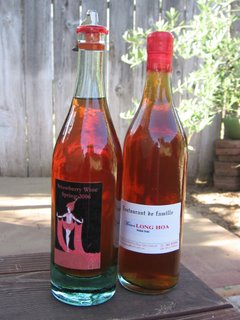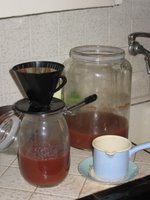
I need to make something clear. Despite that two of my first five posts on Serve It Forth are about making alcohol, I am not a boozehound. I kept only a few of the 25 bottles of limoncello that I recently made (and these I saved for sipping with friends), and the strawberry wine I am writing about now is a crucial part of Communion. Most Vietnamese women I know make their own fruit liqueurs to serve after meals as digestifs.
I first had strawberry wine in the fall of 1995, in the hill town of Dalat, about six hours north of Saigon. It was my first weekend out of the city, and I needed the escape from hot urban living. Cool and quiet, Dalat is home to the Dalat Palace, my favorite hotel in the world, and Maison Long Hoa, a hushed, simple, elegant Vietnamese restaurant where Beethoven rather than ABBA plays over the stereo. As my then boyfriend and I chatted with the ever-gracious owner, Mr. Thai, he suggested we try the restaurant’s strawberry wine, which was made by his wife. It was three years old, and it was syrupy, sweet, and good. We bought two bottles with the intention of saving them for special occasions back in Saigon. Instead, we drank both by the time we got back to the hotel. In our defense, it was a long walk back, with digressions into shuttered market stalls to try on hats, and the Stop & Go during the blackout hour for flamenco music and an impromptu poetry writing session. And yes, we had hellacious headaches the next morning.
When my sister and I traveled back to Vietnam last year to research Communion, we stopped in at Maison Long Hoa, for clay pot fish, beef in la lot leaves and some strawberry wine. Mr. Thai’s wife still makes it, and it is still good. We bought a bottle, and later, when I was talking about it with our local translator, Linh, I was told that every good housewife in Dalat knows how to make it. It’s easy, she assured me. She gave me her recipe to try at home. I started a first batch this January, and a second batch in April. The first batch was in bottles in March. I have to say, when I looked at that jewel-like red liquid in those three bottles, I was very proud of myself. And so I took a bottle to the big Vietnamese feast we cooked for our friends and a small group of winemakers last month in Paso Robles.
We shouldn’t have waited until the end of the night to sample it. Everyone had had a little too much to drink by then, and people were in playful but feisty moods. The winemakers first sampled a Vietnamese made red table wine that Julie and I brought, and they made a big show of sputtering, spitting it out, and wrinkling their noses. Out of the kindness of his heart—when it came time for my strawberry wine—the owner of L’Aventure assured me that he liked its berry notes. My friend Joel smilingly announced, “Well, at least this one’s drinkable.” And then one of Joel’s colleagues, Soren, commented on the slightly brown tint of the liquid and gave me a well-intentioned half-hour lecture on oxidization and bacterial fermentation. I just wanted to put fruit and sugar in a jar and see if I could make booze like all my friend’s moms do in Vietnam. I decided not to bust out Mr. Thai’s wife’s wine for such unforgiving criticism, and instead kept it for a crowd I was sure would appreciate it: my undiscriminating girlfriends.
A few weeks later, Julie and I gathered with Michelle, Hilary and Sarah at our friend Vickie’s house on a Sunday afternoon for a barbecue. Before the festivities got underway, I asked them to do a taste test with the Vietnamese strawberry wine and my wine. I knew I could count on my girls. They liked both, but they liked mine best. They said you could really taste the fresh strawberries in it. I guess that would be the “berry notes” mentioned up in Paso! The Vietnamese version was much darker and richer, perhaps because it had been in the bottle for two years. Michelle decided that it tastes like a white port. She also compared both versions to Manischewitz, which might not be taken as a compliment unless you know how much Michelle likes that saccharine wine. All were impressed by the fact that I’d even made wine—thank you, ladies!—and a long discussion ensued, led by my sister, about the possibilities, had we known as teenagers that it was so easy to make wine in a jar. We also decided that strawberry wine is very nice chilled over ice.
I am the first to admit that my winemaking efforts are uneducated and crude (I know nothing about fermentation, alcohol content, and so on), but at the same time, the result made me happy. I think I’m going to try apricot wine next. In the meantime, here is the end result of how I did it. If anyone has suggestions or recommendations, feel free to send them my way.

Linh’s Strawberry Wine
Ingredients:
- 1-gallon jar with a lid
- 10 lbs strawberries
- 2 lbs sugar
Note on Fermentation: If you live in a cold place, you should add a bit of wine yeast.
Directions:
- In the jar, put one layer of strawberries, one layer of sugar, one layer of strawberries, one layer of sugar, and so on until all the strawberries are used up.
- If you live in a cold place and don’t get much sun, mix half a 5-gram packet of wine yeast according to the instructions, and dribble this into the jar.
-Put the lid on the jar and keep it in a warm place (75-80F) for two months. I kept mine in a window where it could get direct sunlight in the afternoons.
- Manually filter the liquid using a plastic screen, Vietnamese style—these are Linh’s instructions, and I love them, although I don’t know what they mean. Below I explain how I filtered the wine. I’m sure my method is equally rudimentary. The liquid should be clear and deep ruby pink in color.
- Pour filtered liquid into a jar and let it sit for another week or two, to let the final sediment sink to the bottom.
- Strain this liquid from the sediment.
- Bottle wine and make beautiful labels.
- Let wine sit for at least another month—more if you have patience—before drinking.
NOTES ON THE PROCESS
Amounts:
The first time I made this I used 5 lbs. strawberries, the second time I doubled the recipe and used 10. Oddly, the first batch yielded more wine than the second. I have no idea why. From the 10 lb. batch, expect approximately two 750ml worth of liquid.
Oxidization:
When putting the strawberries into the jar, don’t leave a lot of air at the top. The jar should be full with just an inch or so of space at the top, to keep the liquid from turning brown.
Fermentation:
Fermentation begins after about five days. It’s fun to watch the concoction start to fizz and bubble. Mine fizzed and bubbled for about a month before becoming just a weird-looking science project in the kitchen. I have seen jars of wine in the making in my Vietnamese friends’ houses. In every case, the fruit rises to the top of the liquid and stays there. In my case, the fruit rose during the first month, and then sank during the second. The strawberries began to look like mushy little sea anemones, sleeping on a thick bed of sediment, and many a visitor compared them to things that I do not want to write about in an essay on food. My advice: just be patient and see what happens. I honestly thought the whole project was going to be a big waste of time, but I now have a few bottles of yummy wine that prove the Doubting Debbie in me wrong.
Potential Explosions:
Linh’s instructions call for an airtight jar. Apparently, if the jar is truly airtight, it will explode. I did not know this, and since I sealed my jar as best I could, I am going to assume that it wasn’t completely airtight. You may want to do more research on this before blowing up a big jar of strawberries in your kitchen.
 My first crude attempts to filter ...
My first crude attempts to filter ...
Filtering:
I have no idea how to filter wine, and so, when confronted with the first batch, I used the only filtering system I know: my coffee filter. My one-cup coffee filter, to be precise. I can’t say my approach was the most efficient, because, as you can see from the two small photos above, I attempted to strain out the strawberries first. What I should have done—and what I did with my second batch—was scoop the liquid out first, and then filter that liquid. I filtered the liquid three times to get it as clear as possible.
Then I put that liquid into a jar, let it sit for two weeks, and VERY CAREFULLY scooped out the liquid, leaving behind the small quarter-inch layer of sediment on the bottom of the jar. I know there are better ways to do this, but I approach these activities as a kind of meditation, and I think half the fun is discovering what you can do, without having any idea what you’re doing.

Flavor:
Right after you have filtered your wine, it will taste a little bitter. It needs to sit in the bottles for a month or so to sweeten up.




6 comments:
Being a lucky recipient of Kim's "private reserve" Limoncello and Strawberry Wine, seeing her great efforts here make them even more special.
The Limoncello is tucked away in the freezer and the Strawberry Wine in a corner of the fridge. Waiting for the right ocassion to share with discriminating palates.
Thank you, so much, Kim for sharing!
My treats for you are on their way!
Tootles,
Anni :-)
Thanks, Anni, I was worried my descriptions might scare you off the wine! Kim
BTW, Kudos on your filtration system!
Tootles,
Anni :-)
My regards to your sister. She's got a good eye.
And now it's my turn to THANK Anni - the fig confiture and mango peach sauce arrived today ... I'm hiding the fig from my sister, who has already told me the dozen things she plans to do with it!
Wow, you have seriously inspired me! We have just begun brewing beer and I was inspired to try my hand at making some sort of "wine" - your recipe seemed a lot simpler than the ones I have read on previous occasions.
May seem like a dumb question - what does it smell like?
This wine really is easy to make. I used the process with apricots, as well. And there are no dumb questions - the smell is sweet, mainly of the fruit, like a liqueur. The key if you don't have lots of sun is the wine yeast. Have fun!
Post a Comment